Dishwasher detergent pods – the dream of every dishwasher owner. They’re mess-free, convenient, and easy to use.
Well, most of the time…
However, sometimes, these little magical capsules of modern dishwashing won’t dissolve during a wash cycle.
Why does that happen? And what are the fixes?
That’s what we’re talking about in this article.
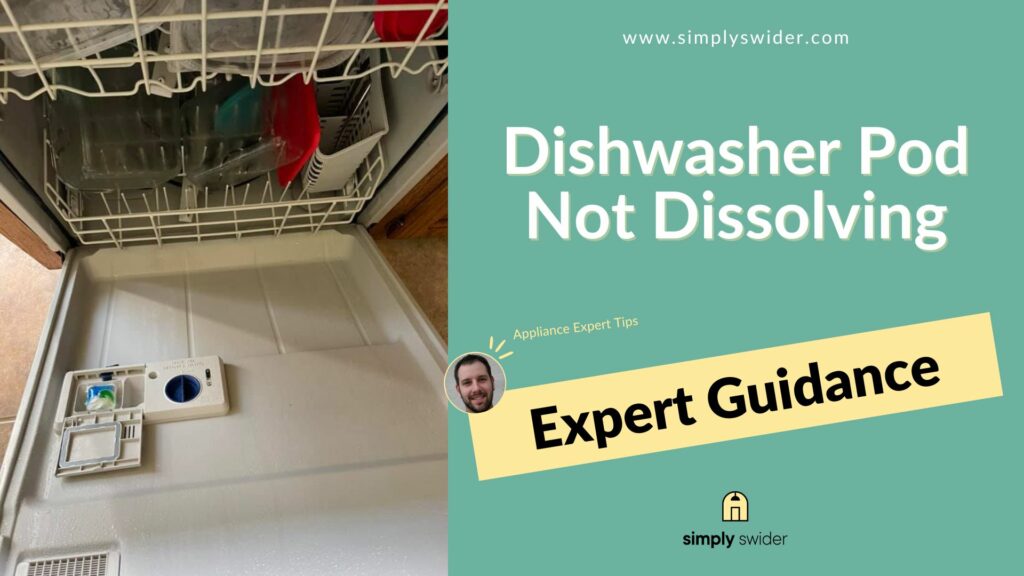
Table of Contents
Why Are My Dishwasher Pods Not Dissolving?
There are a couple of reasons why your dishwasher pods are not dissolving during a wash cycle. First, there could be something blocking the dispenser lid from opening. Secondly, there is not enough water reaching the pod dispenser. The water may not be getting hot enough, or there may be a malfunctioning part in the dishwasher.
In the section below, I will go through each of the causes in detail with the help of Barry Shuster, a seasoned appliance repair technician based in Florida.
Barry provides great insights on why this problem is widespread among all dishwasher brands and pod brands
He says…
“This issue affects all pod brands and dishwasher brands including LG, Frigidaire, Bosch, Samsung, Kenmore, Maytag, among others”
Note:
This article applies to all detergent pod brands. From Cascade, Finish, Palmolive, Mrs. Meyer’s, Dropps, and Seventh Generation, among others.
1. The Detergent Dispenser Is Getting Blocked from Opening

Problem:
What utensils do you place right in front of the detergent dispenser? Is it a pan, cutting board, pot, or another large item?
Well:
One of those items could be blocking the dispenser lid from opening during washing.
That means:
Water doesn’t enter the detergent dispenser to dissolve and flush the pod out.
“Out of all the pod dissolution issues I encounter, about 40% are because of a blocked dispenser lid,” Barry shares.
However:
This is common in dishwashers with flip-top detergent dispensers.
Note:
There are two types of dispenser lid designs: flip-top lid dispensers and sliding lid dispensers.
Because of the design, the lid of the flip-top detergent dispenser is more prone to getting blocked if there is a utensil on the way.
For sliding-lid detergent dispensers, very little space is needed, and it only gets blocked if something is pressing on it.
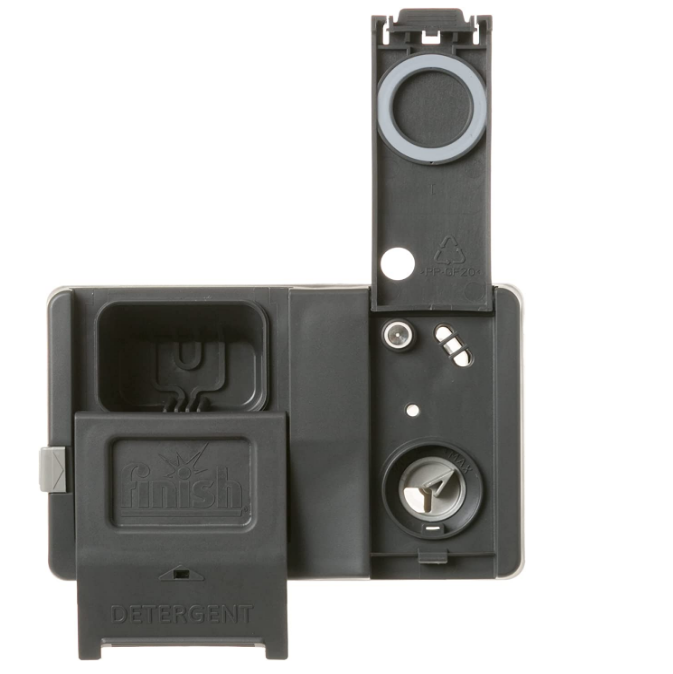
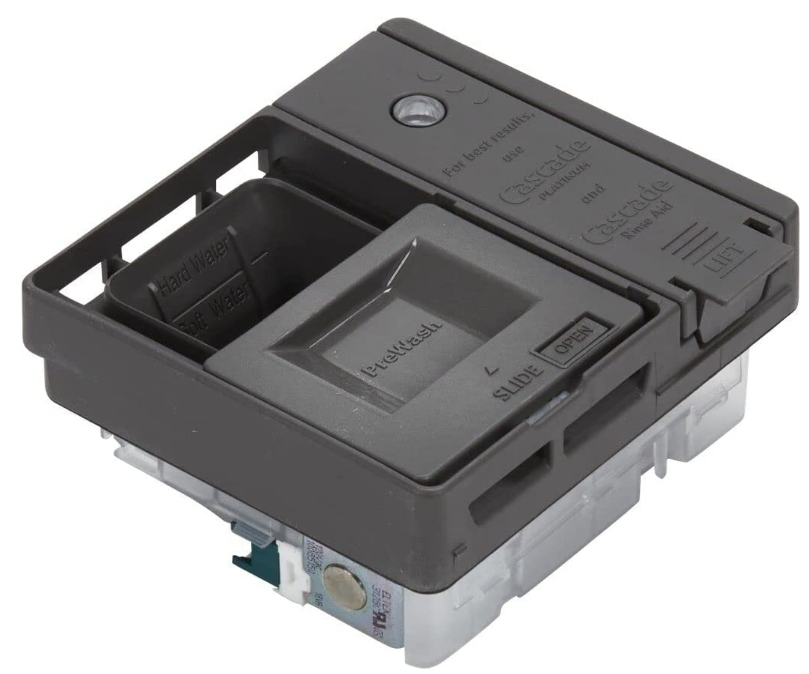
Identification:
First, confirm your dishwasher’s type of dispenser. Then load the dishwasher as you normally do.
Here is the trick…
“While holding the dishwasher door, push the door up until it’s about to close. Then peep inside the washer and see if there is sufficient space for the dispenser lid to open,” Barry advises.
Solution:
When loading your dishwasher, ensure there is no large utensil that would block the detergent dispenser lid.
Also:
Ensure that all the racks are pushed all the way in so that the ends are not blocking the dispenser’s lid.
2. Water Jets Aren’t Reaching the Detergent Dispenser
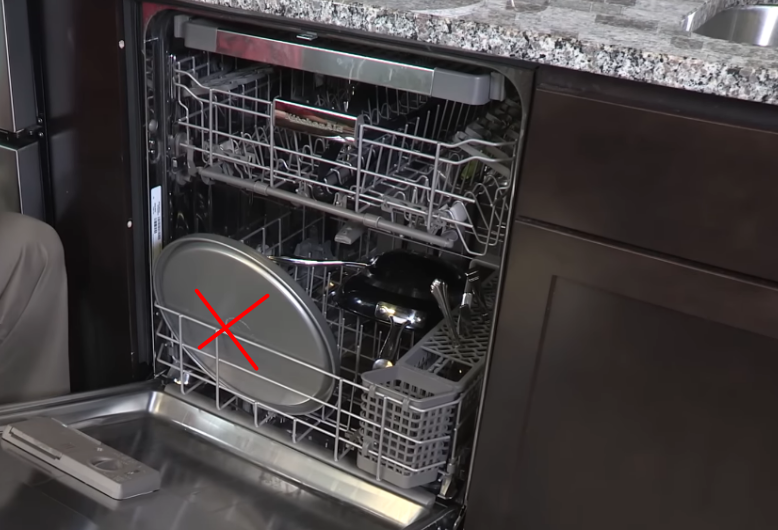
Problem:
By design, pods are meant to be dislodged when water jets from the spray arms hit the open dispenser.
“The problem arises when there is a large item blocking water from reaching the dispenser,” Barry says.
For example:
Recently, Jessi Green, a member of our Simply Swider Appliance Repair Community, was having a similar problem.
When she shared a photo of her Hotpoint LSTF 9H117 dishwasher, the item blocking water from reaching the dispenser was clearly visible.
One of our standby dishwasher technicians advised her to rearrange the utensils and see if the issue would be resolved.
Jessi’s response was, “OMG, your suggestion worked. Moving the pot resolved the issue.”
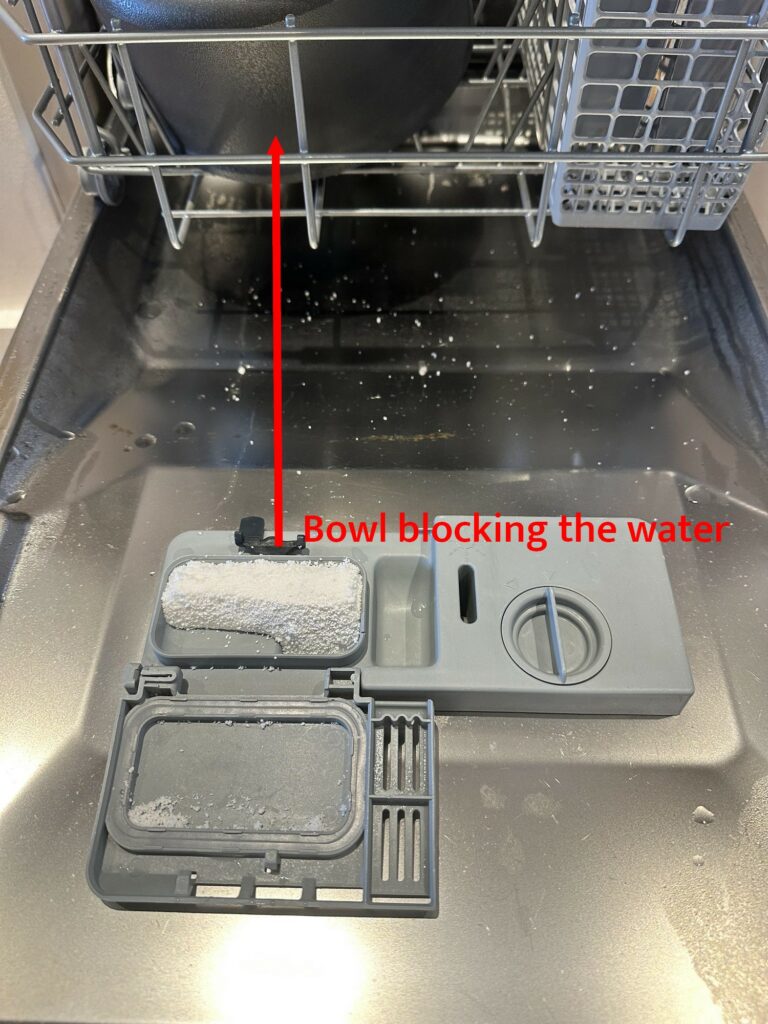
Identification:
Open the dishwasher door and squat down to see if the spray arms are obstructed from the dispenser’s position.
Probably:
Any item blocking the spray arms from the dispenser is the culprit.
Solution:
When loading the dishwasher, ensure that there is a clear path between the dispenser and the spray arm.
Also…
Avoid placing large or tall items in front of the dispenser so that there is unrestricted movement of the water jets.
3. A Problem With The Spray Arms
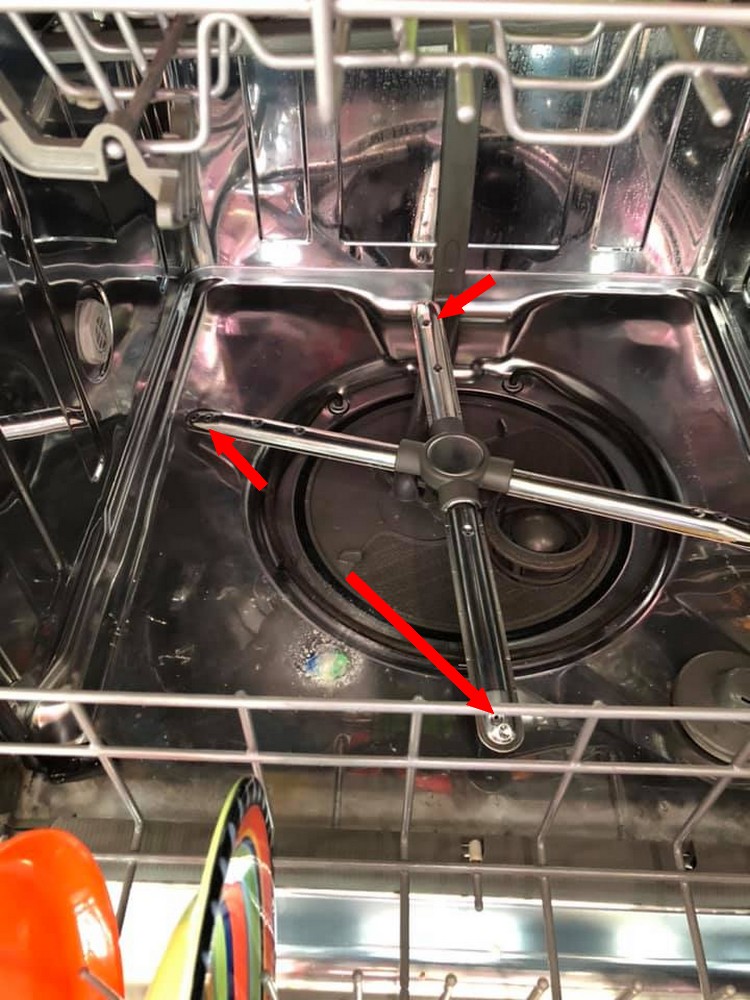
| Part | Spray Arms |
| Location | At the bottom (some dishwashers have an upper spray arm) |
| Ease of troubleshooting | Easy |
| Replacement part cost | $20-$200 depending on the brand or model |
Problem:
Aside from items blocking water from hitting the dispenser, faulty spray arms can also lead to undissolved pods.
According to Barry…
“Faulty simply means that the spray arms are either not rotating, clogged, broken, or misaligned. But also circulation pump for sure.”
And this could be the result of improper item placement, clogs, or overloading.
That said:
A fault in the spray arms can cause the water jets to miss the dispenser, thus leading to the problem at hand.
For example:
“Clogs on the dishwasher spray arms impede water flow and reduce the speed of water coming out,” Barry explains.
Identification:
After loading the dishwasher, manually rotate the spray arms to make sure there is no utensil in the way.
Next:
When the dishwasher is empty, inspect the spray arm holes for any blockages.
This user on Reddit had the same problem with his Whirlpool WDF520PADM6 dishwasher. He discovered there were broken pieces of plate blocking the spray arm holes.
Solution:
If the issue is a blockage, remove the spray arms. To do this,look for a screw or a locking mechanism securing the arms to the hub.
Next:
Using a needle or a toothpick, poke each of the holes to dislodge any clogs.
Then soak the arms in warm water and vinegar solution and let them soak for 15–20 minutes.
Finally, scrub the arms with a toothbrush to remove all the stubborn clogs and mineral buildup.
Reinstall the spray arms and check if the issue has been resolved.
4. A Faulty Detergent Dispenser
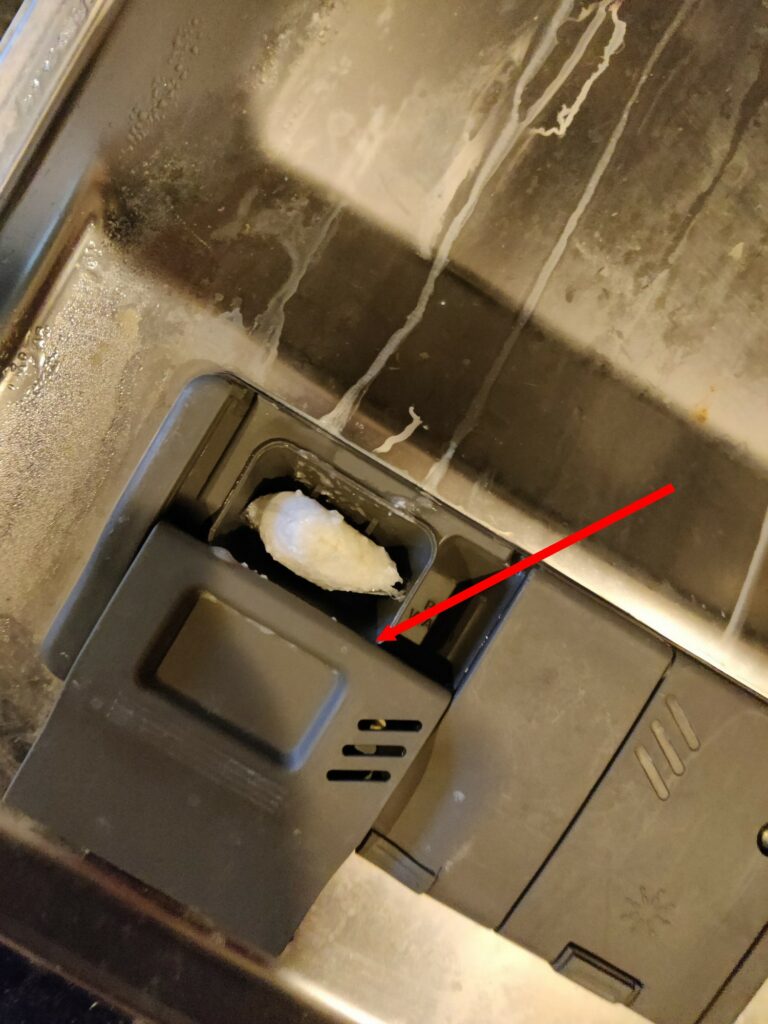
| Part | Detergent dispenser |
| Location | On the inner side of the dishwasher door |
| Ease of troubleshooting | Easy |
| Replacement part cost | $50-$200 depending on the brand and model |
Problem:
At a particular moment during the wash cycle, the dishwasher triggers the pod dispenser to open.
However:
Sometimes the dispenser opens late in the cycle or won’t open at all because of a mechanical problem.
According to Barry…
“This can be caused by a broken spring or a faulty latch.”
Identification:
The first sign that this is the problem is when you find the dispenser still locked after a wash cycle.
Next:
Test the dispenser by locking and unlocking it. If it feels wobbly or stiff, that could signify a mechanical problem.
Also:
Check if the washer is displaying a dispenser problem error code, which differs from one model to another.
Solution:
The fix here will depend on the specific issue and cause. Some issues, such as a broken spring, are repairable, while others are not.
If the dispenser mechanism or some of its components are damaged or worn out, you may have to replace them.
5. The Pod Is Getting Stuck In The Dispenser
Problem:
“One simple mistake that I see people make is handling dishwasher pods with wet hands,” Barry says.
Why?
When the pod’s outer layer gets wet during placement, it can get stuck in the dispenser before it’s released. This makes it harder to dislodge it when the dispenser opens.
Note:
The pod stays in the dispenser for up to 20 minutes before it opens.
Solution:
Ensure your hands are dry and wipe the dispenser dry before introducing the pod.
6. The Water Is Not Hot Enough
Problem:
“Every dishwasher manual specifies the recommended washing temperature for the best cleaning results,“ Barry says.
For instance:
| Whirlpool Dishwashers | 120°F |
| Maytag Dishwashers | 120-145°F |
| Samsung Dishwashers | 120 – 149°F |
| Frigidaire Dishwashers | 120°F – 140°F |
| Miele Dishwashers | 120°F- 140° F |
| LG Dishwashers | 120 – 149°F |
| Whirlpool Dishwashers | 120°F – 140°F |
Also:
“Every detergent pod specifies the most ideal temperature range, which is always within most dishwashers’ temperature range,” Barry continues.
For instance:
| Cascade pods | 120°F – 140°F |
| Finish pods | 125°F – 140°F |
| Seventh Generation pods | 120°F |
| Ecover pods | 120°F |
If the water temperature is not within the recommended range, it can cause dissolving problems.
This is because pods usually don’t activate well in cold water.
Causes of water not getting hot enough include:
- A problem with the dishwasher heating element.
- When the water heater is not set at the right temperature.
- Starting the dishwasher when the water is still cold.
- The dishwasher’s temperature is set to low.
Identification:
Here’s how to test for low temperatures:
- Check the temperature of the water coming out of the washer.
- Feel if the utensils are warm after a wash cycle.
- Check if the dishwasher is displaying water heating-related error codes.
- Fill a glass with water from the sink, then measure its temperature with a thermometer.
Solution:
The fix here will depend on the specific cause.
If you have set the right temperature on the heater but the water is still not hot enough, the heater may have a problem.
In that case, consult an electrician.
Next:
Ensure you have set the dishwasher to the right temperature, following the washing machine’s and pod’s recommendations.
If the machine’s heating element has a problem, consult a repair technician.
Also:
Wait until the water is hot before starting the dishwasher.
Barry says…
“Run the kitchen faucet on for a few minutes to make sure the water is hot enough when you start the dishwasher.”
7. You Are Using Low-Quality, Old, or Damaged Pods
Problem:
Dissolving issues can also be caused by using low-quality, old, or damaged pods.
Barry says…
“Poor-quality pods have a subpar formulation, whereas expired ones have a degraded formulation, resulting in dissolution problems.”
Also:
If the pods have hardened from improper storage, they won’t dissolve properly.
Identification:
Start by doing a visual inspection to determine how the pods look and feel.
Ideally, they should have a firm and consistent texture. If they are extra hard, gummy, or soft, they may be damaged.
Next:
“Place a few pods in hot water at 120°F and observe how they will dissolve,” Barry says.
If they don’t dissolve completely, they may be damaged. However, dissolution will not be as swift as it would be in the dishwasher since the water is still.
Solution:
Consult the manufacturer’s instructions on how to store the pods. Also, inspect the pods regularly to make sure they are in good condition.
Safety reminder!
Keep the pods away from children and pets. Every year, there are thousands of cases of children ingesting dishwasher detergent.
8. Low Water Pressure
| Part | Water fill valve |
| Location | At the back of the dishwasher |
| Ease of troubleshooting | Hard |
| Replacement part cost | $20-$100 depending on the brand and model |
Problem:
Different dishwasher brands recommend specific water pressure levels, which range between 20 and 120 psi.
If the water entering the dishwasher lacks sufficient pressure, the water jets won’t be strong enough to dislodge the pod from the dispenser.
Identification:
First, check if the water supply valve is fully open, as it determines the amount of water getting into the dishwasher.
Secondly, inspect the water inlet valve that controls the flow of water into the machine.
It is located at the back of the dishwasher, where the water supply line connects to the machine.
Thirdly, test your home’s water pressure.
That said:
“To confirm that low water pressure is the cause, pour a jug of water at the bottom of the washer before starting a cycle and observe if the problem will be resolved,” Barry recommends.
Solution:
The specific solution will depend on what’s causing the low pressure.
For instance:
| Cause | Solution |
|---|---|
| The water supply valve is not fully open | Open it fully |
| Damaged or blocked water inlet valve | Consult a dishwasher repair technician |
| Low water pressure in the household | Consult a plumber |
| Restricted water supply line | Consult a plumber |
Brand-Specific Issues and Solutions
Some dishwasher brands recommend a specific pod brand. This table lists the pod brands that some of the most popular dishwasher brands recommend.
| Dishwash Brand | Recommended Pod Brand |
|---|---|
| GE Appliance Dishwashers | Cascade |
| Profile | Cascade |
| Whirlpool | Cascade |
| Maytag | Cascade |
| KitchenAid | Cascade |
| Kenmore | Cascade |
| Electrolux | Cascade |
| Frigidaire Dishwashers | Cascade |
| Midea | Cascade |
| LG | Cascade |
| Bosch | Finish |
| Samsung Dishwashers | Cascade |
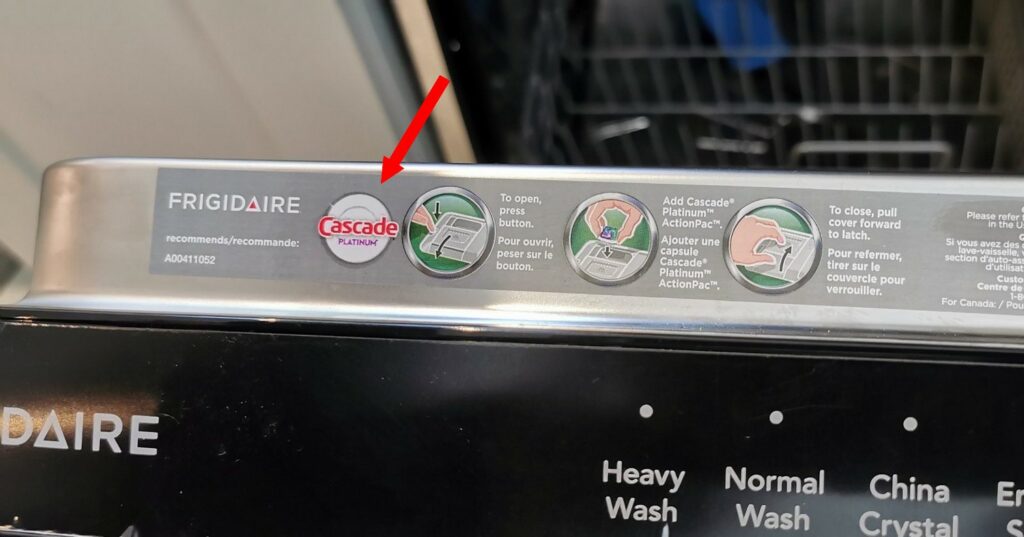
Conclusion
Here is the thing: dishwasher pods don’t deserve a bad rap.
While it’s true that they occasionally fail to dissolve, it is often a minor issue that can be easily fixed.
Some of the causes include blocking the dispenser lid, water not reaching the dispenser, and water not getting hot enough.
Sometimes the cause can be a faulty part, such as a faulty detergent dispenser or spray arms.
In this case, you may require the services of a professional appliance repair technician, depending on the severity of the issue.
Finally:
Also, check our ‘Ask the Expert’ page for one-on-one assistance with your appliances.
Frequently Asked Questions
Not necessarily. The common causes of dishwasher pods not dissolving are basic issues that are easy to diagnose and fix.
For instance, when there is something blocking the dispenser lid or very little water reaching the dispenser.
The trick is to list down all the possible causes we have discussed, then check each one of them.
If you have confirmed none of the suggested causes is the culprit, try using a different brand of pods and see if they will dissolve, or switch to liquid or powder soap.
An expert appliance technician can help you identify the cause and suggest a solution.
Regular maintenance is key to keeping the machine running smoothly and avoiding pod dissolution issues.
I’d suggest a monthly routine check for parts such as the spray arms, detergent dispenser, and water inlet.

